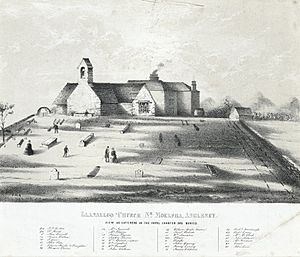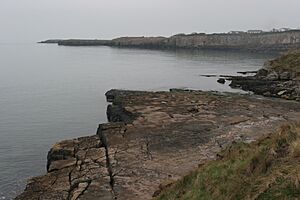Royal Charter (ship) facts for kids

The Royal Charter sank in an 1859 storm, stimulating the establishment of modern weather forecasting.
|
|
Quick facts for kids History |
|
|---|---|
| United Kingdom | |
| Name | Royal Charter |
| Owner | Liverpool & Australian Steamship Navigation Company |
| Builder | Sandycroft Ironworks, River Dee, Deeside, Wales, UK |
| Launched | 1855 |
| Fate | Wrecked on 25 October 1859 |
| Sunk: | 53°22′17″N 4°15′20″W / 53.37139°N 4.25556°W |
| General characteristics | |
| Class and type | Steam clipper |
| Tonnage | 2,719 GRT |
| Length | 236 ft (72 m) |
| Beam | 39 ft (12 m) |
| Depth of hold | 23 ft (7.0 m) |
| Installed power | 200 nhp |
| Propulsion |
|
The Royal Charter was a special kind of ship called a steam clipper. It sank off the coast of Anglesey, Wales, on October 26, 1859. This ship used both a steam engine and large sails to travel. It was carrying many people, and sadly, most of them lost their lives. About 450 people died, making it the worst shipwreck ever on the Welsh coast. The Royal Charter was also the most famous ship lost during a huge storm known as the Royal Charter Storm, which wrecked about 200 ships.
The Royal Charter was built in 1855 at Sandycroft Ironworks on the River Dee. It was a new type of ship for its time. It weighed 2719 tons and had a strong iron body. It was built like a fast clipper ship but also had steam engines. These engines were very useful when there wasn't enough wind for the sails.
The ship traveled between Liverpool in England and Australia. It was mainly used for passengers, but it could also carry some cargo. It had space for up to 600 passengers, with fancy rooms for first-class travelers. People thought it was a very fast ship. It could travel to Australia, going around Cape Horn, in less than 60 days.
Contents
The Shipwreck of the Royal Charter
In October 1859, the Royal Charter was sailing back to Liverpool from Melbourne, Australia. On board were about 371 passengers and 112 crew members. Many passengers were gold miners who had found a lot of gold in Australia. They were carrying large amounts of gold with them. The ship was also carrying a lot of gold as cargo.
As the ship got close to Anglesey on October 25, the weather started to get very bad. The wind grew stronger, reaching storm force. Some passengers later said that the captain, Thomas Taylor, was told to find shelter in Holyhead harbor. But he decided to keep going towards Liverpool.
Near Point Lynas, the Royal Charter tried to pick up a local pilot who guides ships. However, the wind was too strong, and the sea was too rough. During the night of October 25-26, the storm became incredibly powerful, reaching hurricane force. This storm became known as the "Royal Charter Storm."
As the wind got stronger, it changed direction, pushing the ship towards the coast of Anglesey. At 11 PM, the ship dropped its anchors. But at 1:30 AM on the 26th, one anchor chain broke. An hour later, the second chain snapped. Even though the crew cut down the masts to reduce the wind's push, the ship was forced towards the shore. Its steam engines could not move against the strong winds.
The ship first hit a sandbank. But in the early morning, the rising tide pushed it onto the rocks. This happened just north of Moelfre, at a place called Porth Alerth. The ship was smashed against the rocks by huge waves, driven by winds over 100 miles per hour. It quickly broke apart.
Rescue Efforts and Sad Losses
One brave crew member, Guzi Ruggier (also known as Joseph Rogers), managed to swim to shore. He carried a rope with him, which helped a few people get rescued. A few others were able to fight their way through the waves to the shore. But most of the passengers and crew, over 450 people, died. Many were killed by being thrown against the rocks by the waves. Others drowned, some weighed down by the gold they were carrying. Only 21 passengers and 18 crew members survived, and all of them were men. No women or children were saved.
A lot of gold was found on the beach at Porth Alerth after the wreck. Some families living nearby became rich overnight from the gold. The gold carried as cargo was worth a lot of money. But the total value of all the gold on the ship was much higher. Many passengers had large amounts of gold on them or in the ship's safe. Many bodies found from the sea were buried at St Gallgo's Church, Llanallgo. You can still see the graves and a memorial there today. There is also a memorial on the cliff above the rocks where the ship hit.
After the disaster, some people claimed that local residents were taking gold from the wreck or taking advantage of the victims' families. A group of 28 people from Moelfre, who helped with the rescue, wrote a letter to The Times newspaper. They wanted to explain what really happened and deny the accusations.
Almost exactly 100 years later, in October 1959, another ship called the Hindlea hit the rocks in nearly the same spot during another storm. This time, the outcome was different. The Moelfre lifeboat, led by its coxswain Richard Evans, successfully saved the entire crew.
What Happened After the Disaster
The famous writer Charles Dickens wrote about the disaster in his book The Uncommercial Traveller. Dickens visited the area and spoke to the local church leader, Reverend Stephen Roose Hughes. The Reverend worked very hard to find and identify the bodies, which may have led to his own early death. Dickens described how powerful the storm was:
- "So tremendous had the force of the sea been when it broke the ship, that it had beaten one great ingot of gold, deep into a strong and heavy piece of her solid iron-work: in which also several loose sovereigns that the ingot had swept in before it, had been found, as firmly embedded as though the iron had been liquid when they were forced there."
Dickens's friend, the painter Henry O'Neil, created a painting in 1860 called A Volunteer. It was based on the event and showed Joseph Rogers about to jump into the sea with the rope.
The Royal Charter disaster had a big impact on the development of the Meteorological Office, which is the UK's weather service. Captain Robert FitzRoy, who was in charge of the office, started the first gale warning service. This was done to prevent similar tragedies in the future. The strength of the "Royal Charter storm" was often used as a way to measure other big storms. For example, when the Tay Bridge collapsed in 1878, the Astronomer Royal often mentioned the Royal Charter storm in his report.
The ship's remains were salvaged (recovered) soon after the disaster. Today, parts of the wreck, like iron walls and ribs, lie close to the shore in shallow water. They are sometimes covered and uncovered by shifting sands. Over the years, scuba divers have found gold coins, pistols, glasses, and other personal items. Teams have continued to search for treasure as recently as 2012.
Britain's Biggest Gold Nugget
In 2012, a gold prospector named Vincent Thurkettle found what is believed to be Britain's largest gold nugget. He found it while searching the waters near Anglesey. He kept his discovery a secret until May 2016 while he and his friends continued to look for more items from the Royal Charter. The nugget weighed 97 grams and was found in about 5 meters of water, about 5 meters from the shore. It was about 40 meters from where the Royal Charter sank. Because of this, Thurkettle had to tell the Receiver of Wreck, who took possession of it for the Crown (the government). Recent storms had moved sand away, revealing parts of the seabed that had been hidden for a long time.
Images for kids
-
The Royal Charter Memorial in the churchyard of St Gallgo's Church, Llanallgo









